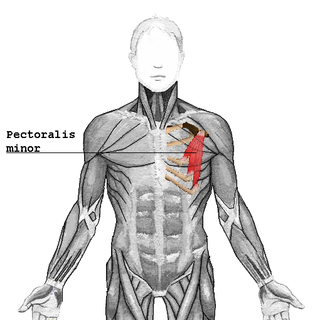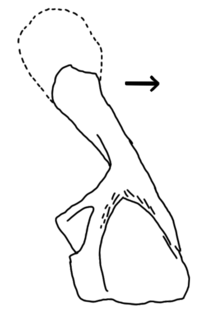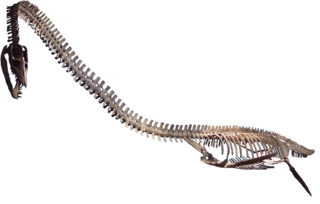Related Research Articles

The clavicle, or collarbone, is a long bone that serves as a strut between the shoulder blade and the sternum (breastbone). There are two clavicles, one on the left and one on the right. The clavicle is the only long bone in the body that lies horizontally. Together with the shoulder blade, it makes up the shoulder girdle. It is a touchable bone, and in people who have less fat in this region, the location of the bone is clearly visible, as it creates a bulge in the skin. It receives its name from the Latin clavicula, because the bone rotates along its axis like a key when the shoulder is abducted. The clavicle is the most commonly fractured bone. It can easily be fractured due to impacts to the shoulder from the force of falling on outstretched arms or by a direct hit.

In human anatomy, the acromion is a bony process on the scapula. Together with the coracoid process it extends laterally over the shoulder joint. The acromion is a continuation of the scapular spine, and hooks over anteriorly. It articulates with the clavicle to form the acromioclavicular joint.

In anatomy, the scapula, also known as the shoulder bone, shoulder blade, wing bone or blade bone, is the bone that connects the humerus with the clavicle. Like their connected bones, the scapulae are paired, with each scapula on either side of the body being roughly a mirror image of the other. The name derives from the Classical Latin word for trowel or small shovel, which it was thought to resemble.

The coracoid process is a small hook-like structure on the lateral edge of the superior anterior portion of the scapula. Pointing laterally forward, it, together with the acromion, serves to stabilize the shoulder joint. It is palpable in the deltopectoral groove between the deltoid and pectoralis major muscles.

The pectoralis minor is a thin, triangular muscle, situated at the upper part of the chest, beneath the pectoralis major in the human body.

Masiakasaurus is a genus of small predatory theropod dinosaurs from the Late Cretaceous of Madagascar. In Malagasy, masiaka means "vicious"; thus, the genus name means "vicious lizard". The type species, Masiakasaurus knopfleri, was named after the musician Mark Knopfler, whose music inspired the expedition crew. It was named in 2001 by Scott D. Sampson, Matthew Carrano, and Catherine A. Forster. Unlike most theropods, the front teeth of M. knopfleri projected forward instead of straight down. This unique dentition suggests that they had a specialized diet, perhaps including fish and other small prey. Other bones of the skeleton indicate that Masiakasaurus were bipedal, with much shorter forelimbs than hindlimbs. M. knopfleri reached an estimated adult body length of around 2 metres.

Hynerpeton is an extinct genus of early four-limbed vertebrate that lived in the rivers and ponds of Pennsylvania during the Late Devonian period, around 365 to 363 million years ago. The only known species of Hynerpeton is H. bassetti, named after the describer's grandfather, city planner Edward Bassett. Hynerpeton is known for being the first Devonian four-limbed vertebrate discovered in the United States, as well as possibly being one of the first to have lost internal (fish-like) gills.

The shoulder girdle or pectoral girdle is the set of bones in the appendicular skeleton which connects to the arm on each side. In humans it consists of the clavicle and scapula; in those species with three bones in the shoulder, it consists of the clavicle, scapula, and coracoid. Some mammalian species have only the scapula.
Texasetes is a genus of ankylosaurian dinosaurs from the late Lower Cretaceous of North America. This poorly known genus has been recovered from the Paw Paw Formation near Haslet, Tarrant County, Texas, which has also produced the nodosaurid ankylosaur Pawpawsaurus. Texasetes is estimated to have been 2.5–3 m (8–10 ft) in length. It was named by Coombs in 1995.

Neuquensaurus is a genus of saltasaurid sauropod dinosaur that lived in the Late Cretaceous, about 80 million years ago in Argentina and Uruguay in South America. Its fossils were recovered from outcrops of the Anacleto Formation around Cinco Saltos, near the Neuquén river from which its name is derived.

The suprascapular notch is a notch in the superior border of the scapula, just medial to the base of the coracoid process.

Elasmosauridae was a family of plesiosaurs. They had the longest necks of the plesiosaurs and survived from the Hauterivian to the Maastrichtian stages of the Cretaceous, with a possible Triassic record in Alexeyisaurus. Their diet mainly consisted of crustaceans and molluscs.

A coracoid is a paired bone which is part of the shoulder assembly in all vertebrates except therian mammals. In therian mammals, a coracoid process is present as part of the scapula, but this is not homologous with the coracoid bone of most other animals.

Noasauridae was a family of diverse theropod dinosaurs from the group Ceratosauria. They were closely related to the short-armed abelisaurids, although most noasaurids had a much more traditional body types generally similar to other theropods. Their heads, on the other hand, had unusual adaptations depending on the subfamily. 'Traditional' noasaurids, sometimes grouped in the subfamily Noasaurinae, had sharp teeth which splayed outwards from a downturned lower jaw.
Palintropus is a prehistoric bird genus from the Late Cretaceous. A single species has been named based on a proximal coracoid from the Lance Formation of Wyoming, dated to the latest Maastrichtian, 66 million years ago. Coracoids and a proximal scapula of two unnamed species from the upper Campanian Dinosaur Park Formation of Alberta, dating to between 76.5 and 75 million years ago, are also known.

Sarahsaurus is a genus of basal sauropodomorph dinosaur which lived during the lower Jurassic period in what is now northeastern Arizona, United States.

Merriamosauria is an extinct clade of ichthyosaurs. It was named by Ryosuke Motani in his 1999 analysis of the relationships of ichthyopterygian marine reptiles and was defined in phylogenetic terms as a stem-based taxon including "the last common ancestor of Shastasaurus pacificus and Ichthyosaurus communis, and all of its descendants." The name honours John Campbell Merriam. Based on this definition, Merriamosauria includes most ichthyosaurs except for several Triassic groups such as the clade Mixosauria, the family Cymbospondylidae, and perhaps the family Toretocnemidae. Merriamosaurs are characterized by features in their pectoral girdles and limb bones, including an extensive connection between the scapula and the coracoid bone, the absence of the first metacarpal and the absence of a pisiform bone.

Barbaridactylus is a nyctosaurid pterosaur from the Ouled Abdoun Basin of Morocco and dates to the Maastrichtian of the Late Cretaceous. It was published in 2018 by Nicholas R. Longrich, David M. Martill, and Brian Andres along with two other nyctosaurs from the same basin, Alcione and Simurghia. It includes one species, Barbaridactylus grandis.

Jinguofortis is a genus of primitive avialan bird belonging to the clade Pygostylia that lived during the Valanginian stage of the Early Cretaceous. It was found in the Dabeigou Formation in northeastern China, and isotope dating from the samples overlying the bird-bearing horizon is 127 million years ago.

Jinguofortisidae is an extinct family of early avialans known from the Early Cretaceous, found in northern China.
References
- Vertebrates Comparative Anatomy, Function, Evolution by Kenneth V. Kardong. Page 325.
| This human musculoskeletal system article is a stub. You can help Wikipedia by expanding it. |
| This vertebrate anatomy–related article is a stub. You can help Wikipedia by expanding it. |